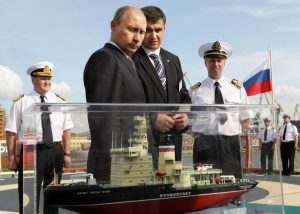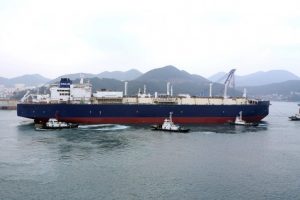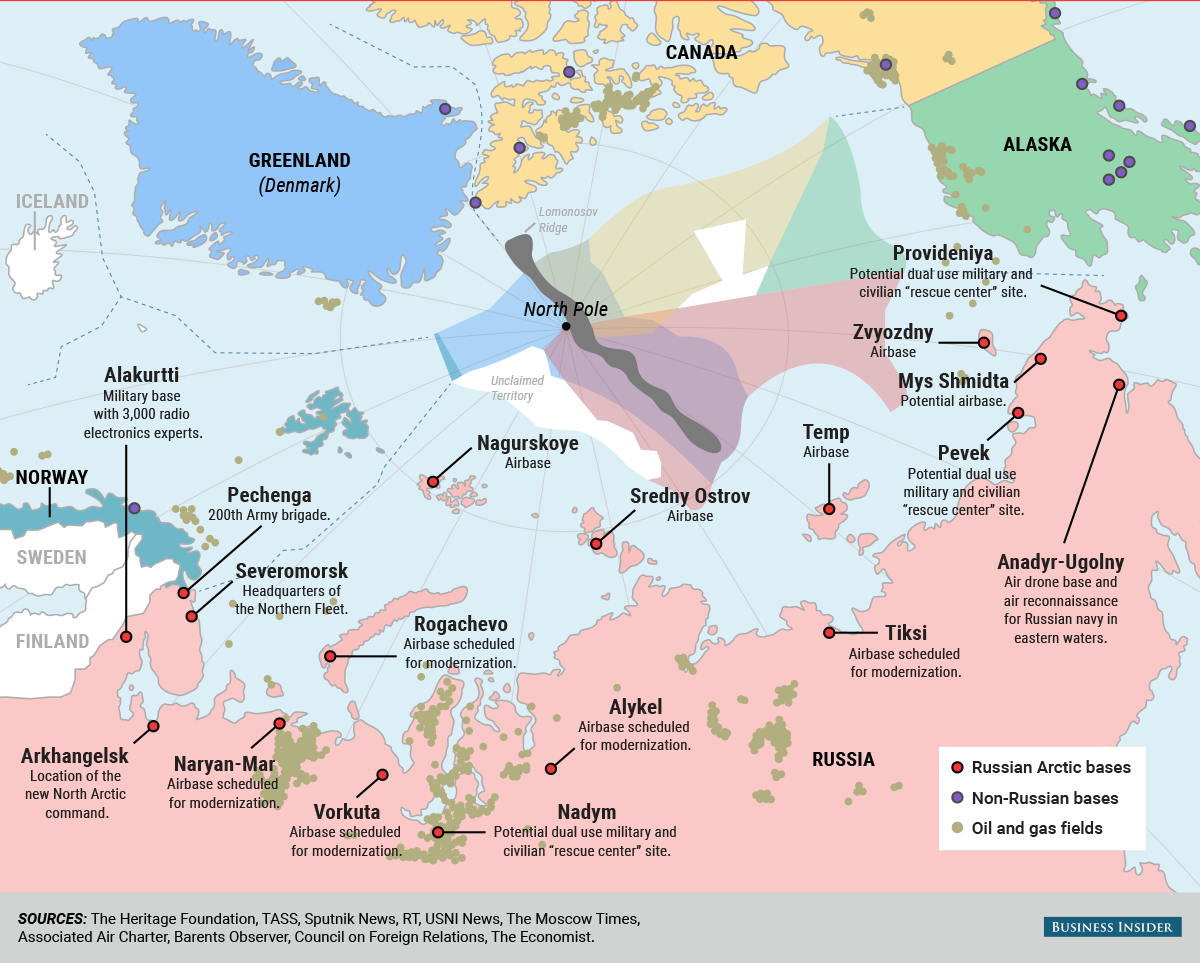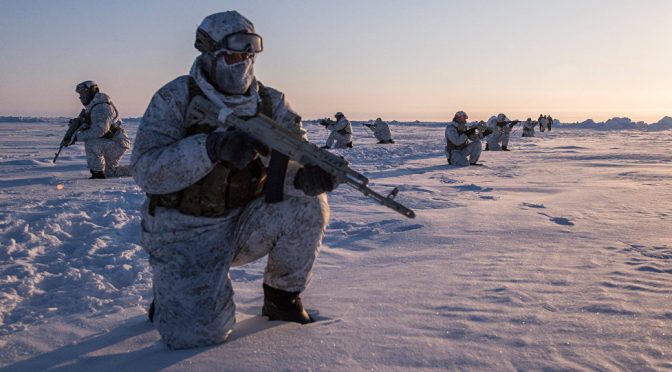By Steve Micallef
Far from the battlegrounds of East Ukraine and Syria another confrontation with Russia is brewing. As the Arctic ice retreats countries with claims in the Arctic are more willing to extract the resources found in this inhospitable location. The U.S. estimates the Arctic seabed is home to about 15 percent of the world’s remaining oil, up to 30 percent of its natural gas deposits, and about 20 percent of its liquefied natural gas. Like the U.S., Canada, Denmark and Norway, Russia has its own claim on a section of the Arctic which it is now looking to defend and expand. Today we are witnessing a resurgent Russia in the Arctic, deploying more troops and equipment to the Arctic in support of its claims.
The Cold History
There is a long history of territorial claims around the North Pole; Canada was the first to claim sovereignty over vast areas of the arctic in 1925. This was followed by the Soviet Union in 1926 which claimed an area stretching from Murmansk, east to the Chukchi Peninsula and north, towards the North Pole including both the Mendeleev and Lomonosov Ridges. This was followed by claims from the U.S., Norway, and Demark that where never internationally recognized until 1999 and the adoption of the United Nations Convention on the Law of the Sea (UNCLOS). UNCLOS, the melting ice caps, and the vast amounts of natural resources on the sea floor are the root causes of current Arctic confrontations.

Under the provisions of UNCLOS, states have ten years after treaty ratification to claim and extend territorial limits beyond the 200-mile Exclusive Economic Zone provided by the convention. Russia ratified UNCLOS in 1997 and had until 2007 to apply for a concession. Whilst Russia has always looked at the Arctic as an integral part of Russian identity (indeed until the collapse of the Soviet Union, Moscow maintained a large presence in the Arctic), it was Vladimir Putin who revived Russian ambitions in the Arctic. In December 2001, Russia applied for an extension of territory, claiming that the Lomonosov Ridge is an extension of the Siberian continental shelf and therefore entitles Russia to a bigger claim in the Arctic. However, this was inconclusive and the UN commission neither rejected nor accepted Russia’s proposal, citing a need for more research.
In the face of the melting icepack the Russian administration has declared the Arctic a region of strategic importance for Russia; due to both the potential Northern Sea Route as well as the energy and rare earth element reserves under the ice. Since 2002, Russia has sent expeditions in support of it claims over Lomonosov Ridge, including a 2007 expedition that planted a Russian flag on the seabed. Vladimir Putin has also taken the bold step of increasing Russian military presence in the inhospitable north.
Icebreaker Development
Icebreakers are the cornerstone of any capability in the Arctic. Icebreakers have multiple uses from resupplying far-flung communities and outposts to scientific exploration, search and rescue, and ensuring that sea lines remain ice-free for shipping. They are the backbone of any presence in the Arctic, both military and civilian. In this department Russian Arctic capabilities are significant, especially when compared to those of other Western claimants.

Russia has as many as 40 icebreakers, both nuclear powered and conventional (see table below). Although some of these vessels are relatively old, with many of them built during the Soviet era, Russia also has various new designs under construction. In total, there are currently some 14 icebreakers of various types being built in Russia.
| Class | Displacement in Tons | Build Qty | Comments |
| Nuclear Powered Vessels | |||
| LK-60Ya
(Project 22220) |
33,540 | 3 | New class of nuclear powered vessels; will be the world’s largest icebreakers. |
| Arktika
(Project 10520) |
23,000 | 6 | Soviet era nuclear vessels- 4 remain in service. |
| Conventionally Powered Vessels | |||
| Project 21900 & 21900M | 10,000 | 2 & 3 | 2x 21900s are in service along with 2x upgraded 21900Ms (1 additional under construction) |
| Ilya Muromets Project 21180 | 6,000 | 4 | First one expected to be delivered in 2017. |
| LK-25 Project 22600 |
22,000 | 1 | Largest diesel-powered icebreaker in the world; may be delivered in 2018 after several years’ delays. |
| Project 70202 | 3,8000 | 1 | Oil spill response, fire extinguishing, and ecological monitoring vessel. Constructed by Finnish Aker Arctic Technology. A unique hull shape allows the vessel to operate efficiently sideways and backwards. |
| Aker Arc 130/A
|
8,699 | 2 | Constructed for Gazprom Neft for use as support ships in Arctic oilfields. Constructed by Aker Arctic. |
| Arc7 ice-classed LNG carriers | 80,200 | 14 | First delivered in 2016, others are under construction in Geoje, South Korea for service in the Arctic. Able to break through 2.1m of ice. |
Of particular interest are the LK-60Ya nuclear ice breakers and Arc-7 LNG carriers. Three LK-60Yas are under construction; the first (the Arktika) was launched in June 2016 and will be commissioned in 2018 with others commissioning in 2019 and 2020. These vessels are intended for use in the Northern Sea Route along Russia’s Arctic coast and are capable of breaking through ice over nine feet thick.

The development of LNG and oil carrying ice-capable tankers is an area of particular economic interest for Russia. In this area, Russia is collaborating with Daewoo Shipbuilding and Marine Engineering in South Korea and an international consortium for the construction of the first Arc 7 ice-classed LNG carriers. The aim is to reliably deliver the LNG produced from the Yamal LNG project in the Yamal Peninsula.
Military Development
Icebreakers are not the only things Russia is constructing to help it control the Arctic. All along its northern frontier Russia has begun rebuilding and reoccupying its military bases, some of which have not been used since the end of the Cold War. Russia is upgrading its docking facilities in Murmansk, one of the few ports which is ice free year round and home to Russia’s nuclear icebreaker fleet, to provide more space for the larger nuclear icebreaker and submarine fleets.
Aerial facilities are also being upgraded to improve coverage over the Arctic. Since 2015 Russia has equipped six new bases in the region, both on the mainland and on islands. These have included airbases on the islands of Franz Josef Land, Severnaya Zemlya, Wrangel Island, Kotelny Island and Novaya Zemlya. On the mainland, the facilities at Mys Shmidta, including the port and the airport, are also being upgraded.

Moreover, the Russian Navy has stepped up its presence in the Arctic with a permanent base on Kotelny Island and in 2016 when it started using new facilities on Alexandra Land. Beyond the ability to conduct search and rescue operations and support other Russian forces operating in the Arctic (mainly through the use of submarine forces), the Navy is also looking to stop infiltration by other powers into sovereign Russian territory.
Weapons-wise, Moscow has deployed two long range S-400 regiments to Novaya Zemlya and the port of Tiksi alongside short range surface-to-air Pantsir-S1 systems to protect them. Arctic bases have also been reinforced with P-800 Oniks supersonic anti-ship missiles, although the number of these systems present in the Arctic remains unclear.
Ground forces are being deployed to the region as well. The 99th Arctic Tactical Group has been permanently deployed to Kotelny Island to protect and aid in the construction of the airfield and piers there. Two other formations, the 200th Independent Motor Rifle Brigade and the 80th Independent Motor Rifle Brigade, have been converted into Arctic Brigades. Both formations appear stationed in the Murmansk Oblast and seem to be equipped with two-tiered tractors, snowmobiles and other vehicles, including the DT-30P Vityaz articulated track vehicle. Allegedly, these troops receive reconnaissance, airborne, and mountain training.
All these elements are under the command of Russia’s Arctic Joint Strategic Command, recently formed in December 2014. This command is responsible for the training and operational employment of Russian assets in the region; including all combat units, radar stations, airfields and support units. Northern Fleet units based at Kotelny Island also fall under the authority of this command.

Russian will continue to build new facilities in the future. A large year-round airbase is being built on the New Siberian Islands Archipelago, which will enable the deployment of Tu-95MS and Tu-160 bomber and the stealth PAK DA bomber in the future. A network of 10 Arctic Search and rescue stations, 16 deep-water ports, 12 new airfields and 10 air-defense radar stations is planned. The Russian Defense Ministry also recently announced it will build over 100 infrastructure facilities in the Arctic by the end of 2017. Together, these units and facilities will allow Russia to maintain a watchful eye over the Arctic, its oil reserves and, in the future, maritime shipping.
Conclusion
Russia has developed its Arctic capabilities to a level that was inconceivable a couple of years ago – one that has not been seen since the end of the Soviet Union. Nor is there is any sign that Russia will stop here – in November 2016 Putin called for accelerating development of the Arctic region. Whatever the outcome, these huge investments in the Arctic leave Russia in a much better position to exploit the benefits brought by the melting ice fields.
Steve Micallef graduated from the University of Malta with a B.A. (Honors) in International Relations in 2015. He also holds an MSc in Strategic Studies from the University of Aberdeen, Scotland. He currently works at Bugeja Geopolitical Consulting, Malta.
Featured Image: Russian arctic troops (Sputnik/ Valeriy Melnikov)

